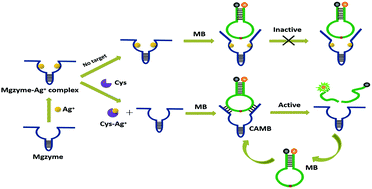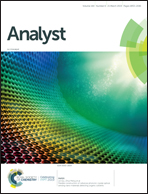Silver-ion-mediated Mg2+-dependent DNAzyme activity for amplified fluorescence detection of cysteine†
Abstract
In this paper, by taking advantage of the fact that silver ions could mediate the Mg2+-dependent DNAzyme (Mgzyme) activity, we for the first time developed a turn-on fluorescent biosensor for amplified cysteine (Cys) detection. Because Mgzyme can interact with the silver ion and form cytosine–Ag+–cytosine (C–Ag+–C) base pairs, the conformation of its catalytic core was changed. As a result, the catalytic activity of Mgzyme was suppressed and the Mgzyme–Ag+ complex could not initiate the cleavage reaction. Therefore, the background fluorescence of the biosensor was very low. In the presence of Cys, Cys can bind tightly to the silver ion and disrupt the C–Ag+–C base pairs in the Mgzyme–Ag+ complex, leading to the restoration of Mgzyme activity. The activated Mgzyme could hybridize with the MB substrate and undergo many cleavage cycles, resulting in a significant increase of fluorescence intensity. This designed strategy provided amplified fluorescence detection of cysteine, with a detection limit of 2 nM. Moreover, the strong binding between Cys and Ag+ ensured that the biosensor had a desirable selectivity for Cys. This sensing system was also used to detect Cys in human urine samples and displayed satisfying results.



 Please wait while we load your content...
Please wait while we load your content...